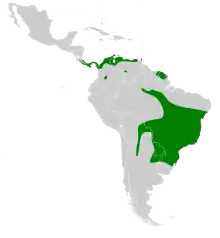Rufous nightjar
The rufous nightjar (Antrostomus rufus) is a species of nightjar in the family Caprimulgidae.
| Rufous nightjar | |
|---|---|
_(15846824680).jpg.webp) | |
| Scientific classification | |
| Kingdom: | Animalia |
| Phylum: | Chordata |
| Class: | Aves |
| Order: | Caprimulgiformes |
| Family: | Caprimulgidae |
| Genus: | Antrostomus |
| Species: | A. rufus |
| Binomial name | |
| Antrostomus rufus (Boddaert, 1783) | |
 | |
| Synonyms | |
|
Caprimulgus rufus | |
It is found in Argentina, Bolivia, Brazil, Colombia, Costa Rica, Ecuador, French Guiana, Guyana, Panama, Paraguay, Peru, Saint Lucia, Suriname, Trinidad and Tobago, and Venezuela.
Its natural habitats are subtropical or tropical dry forest, subtropical or tropical moist lowland forest, and heavily degraded former forest.
Taxonomy
The rufous nightjar was described by the French polymath Georges-Louis Leclerc, Comte de Buffon in 1780 in his Histoire Naturelle des Oiseaux.[2] The bird was also illustrated in a hand-coloured plate engraved by François-Nicolas Martinet in the Planches Enluminées D'Histoire Naturelle which was produced under the supervision of Edme-Louis Daubenton to accompany Buffon's text.[3] Neither the plate caption nor Buffon's description included a scientific name but in 1783 the Dutch naturalist Pieter Boddaert coined the binomial name Caprimulgas rufus in his catalogue of the Planches Enluminées.[4] The rufous nightjar is now placed in the genus Antrostomus that was erected by the French naturalist Charles Bonaparte in 1838.[5][6] The generic name combines the Ancient Greek antron meaning "cavern" and stoma meaning "mouth". The specific epithet is Latin for "red".[7]
Four subspecies are recognised:[6]
- A. r. minimus (Griscom & Greenway, 1937) – south Costa Rica to Colombia and Venezuela
- A. r. rufus (Boddaert, 1783) – south Venezuela, the Guianas and north Brazil
- A. r. otiosus Bangs, 1911 – St. Lucia (Lesser Antilles)
- A. r. rutilus Burmeister, 1856 – south Brazil and east Bolivia to north Argentina
References
- BirdLife International (2016). "Antrostomus rufus". The IUCN Red List of Threatened Species. IUCN. 2016: e.T22689781A93247504. doi:10.2305/IUCN.UK.2016-3.RLTS.T22689781A93247504.en. Retrieved 15 January 2018.
- Buffon, Georges-Louis Leclerc de (1780). "L'engoulevent roux de Cayenne". Histoire Naturelle des Oiseaux (in French). Volume 12. Paris: De L'Imprimerie Royale. pp. 268–270.
- Buffon, Georges-Louis Leclerc de; Martinet, François-Nicolas; Daubenton, Edme-Louis; Daubenton, Louis-Jean-Marie (1765–1783). "Crapaud-volant ou tette-chevre, de Cayenne". Planches Enluminées D'Histoire Naturelle. Volume 8. Paris: De L'Imprimerie Royale. Plate 735.
- Boddaert, Pieter (1783). Table des planches enluminéez d'histoire naturelle de M. D'Aubenton : avec les denominations de M.M. de Buffon, Brisson, Edwards, Linnaeus et Latham, precedé d'une notice des principaux ouvrages zoologiques enluminés (in French). Utrecht. p. 46, Number 735.
- Bonaparte, Charles Lucian (1838). A Geographical and Comparative List of the Birds of Europe and North America. London: John Van Voorst. p. 8.
- Gill, Frank; Donsker, David, eds. (2019). "Frogmouths, Oilbird, potoos, nightjars". World Bird List Version 9.2. International Ornithologists' Union. Retrieved 21 July 2019.
- Jobling, James A. (2010). The Helm Dictionary of Scientific Bird Names. London: Christopher Helm. pp. 50, 343. ISBN 978-1-4081-2501-4.
